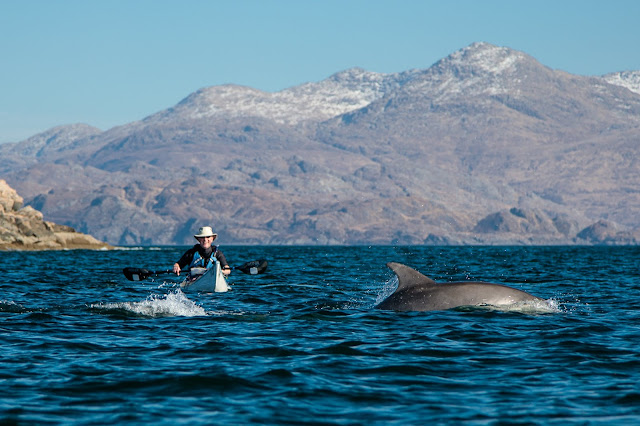25/03/2017
After our first luncheon it was time to return to the boats. This is the P&H Scorpio HV Mk2 in CoreLite X. It is very large but supremely comfortable and as can be seen from the previous post, made an excellent stable platform for photographing bottlenose dolphins. Talking of which......no sooner had we launched than we were pounced upon by the pod which had been lying in ambush just offshore.
The tide had turned and the wind had got up, creating some wonderful kayaking conditions off the headlands. The flying spray, the sunshine the motion of the boats and leaping dolphins made for a simply unforgettable experience.
Unfortunately I did not risk taking my SLR out and my little Olympus TG4 camera had so much shutter lag that I ended up with a lot of photos of splashes where the dolphins had been. Despite the lack of photos this was an even more intense experience as the dolphins were also revelling in the rough water. They would suddenly appear out of our wave and flash across our bows before reappearing just ahead of us. It seemed that they were leading us to the shelter...
...of Port nam Murrach. Once we were safe in the calm of the bay, the dolphins disappeared for good.
Back on dry land we could hardly believe how lucky we had been to experience such a wild life safari and spectacle. You could spend thousands of pounds travelling across the world for such experiences. We had woken in our own beds that morning and so far it had just cost 13 litres of diesel fuel (£17) on the drive up. Donald had spent maybe another £2 to put petrol in his 6hp outboard.
Pleased with our economical adventuring, we wandered round this delightful spot at the edge of the Sound of Arisaig. I have in the past travelled the World and been lucky to get to many amazing places off the beaten tourist track but sometimes you do not need to go far, especially if you live on the west coast of Scotland. Another factor for me is the cost of health insurance to travel out with the UK. Last year it was £1,100!
In the distance the long finger of Ardnamurchan stretched away to the west, beyond the sparkling waters of the Sound of Arisaig to the Sea of the Hebrides beyond.
It was with some reluctance that we made our way back to the turquoise waters of the bay but...
..our friends would be shortly arriving and so we set off...
...across the Sound of Arisaig again with the ...
...sun rapidly dipping in the west.























































